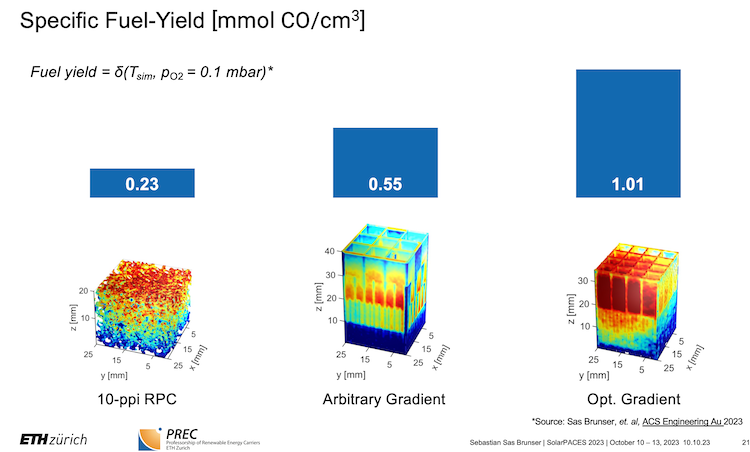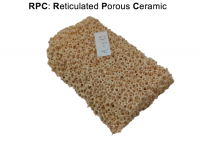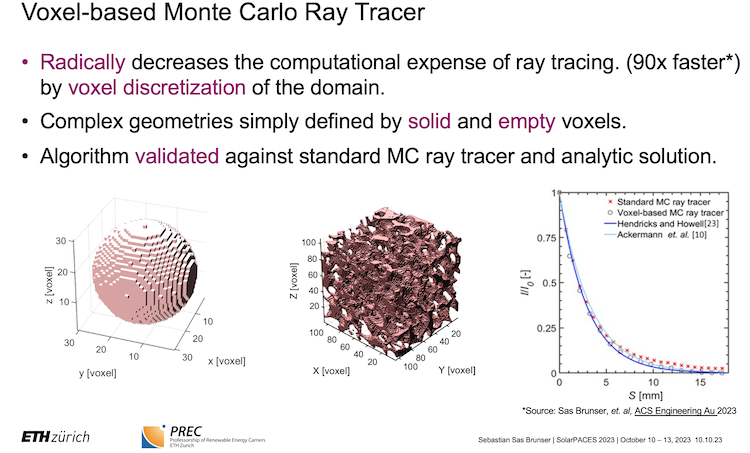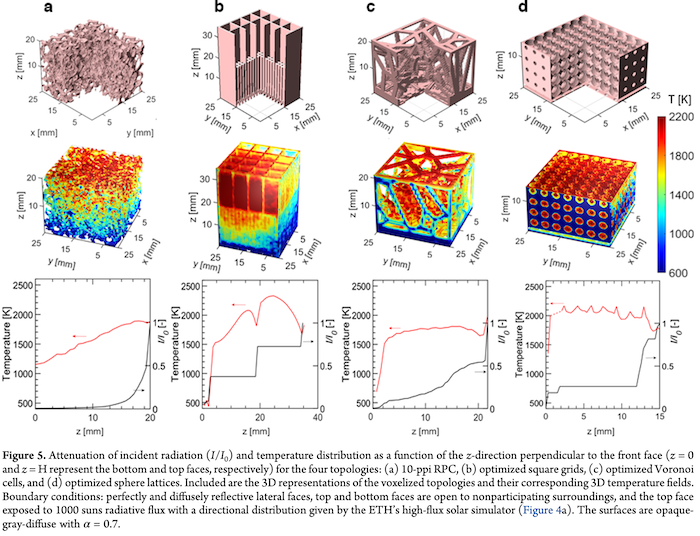
3D-printing the right ceria construction permits incoming warmth from a photo voltaic subject of mirrors to unfold evenly all through a photo voltaic reactor.(How photo voltaic fuels are made: thermochemistry) IMAGE@Sebastian Sas Brunser
3D-printed ceria was one of many many good concepts introduced by worldwide photo voltaic researchers at this 12 months’s SolarPACES Convention in Sydney. In photo voltaic reactors for making photo voltaic fuels at excessive temperatures, ceria’s conduct when heated makes it state-of-the-art for unlocking the thermochemistry concerned. (How photo voltaic fuels are made). However its construction lacks “clever design.”
So a exactly managed design that heats extra evenly might revolutionize effectivity; reducing price and dashing commercialization of photo voltaic fuels like jet gasoline for aviation.
We interviewed Sebastian Sas Brunser, the co-author with photo voltaic fuels pioneer Aldo Steinfeld at ETH-Zurich about their paper Design and Optimization of Hierarchically Ordered Porous Buildings for Photo voltaic Thermochemical Gas Manufacturing Utilizing a Voxel-Based mostly Monte Carlo Ray-Tracing Algorithm, printed in ACS Engineering Au.
Was this a novel thought; to 3D-print the ceria?
Oh no, there’s been progressive analysis on various ceria topologies for years. At Professor Steinfeld’s laboratory at ETH-Zurich, there was already a mission on new ceria buildings created through the replication methodology. However again then, solely the templates had been 3D printed, so we weren’t printing with ceria instantly.
What was the issue with that earlier methodology?
The replication methodology was fairly limiting. To fabricate these varieties, you begin with a plastic template, coat it with a ceramic slurry of ceria, after which sinter it. The sintering course of burns the plastic templates and sinters the ceramic particles within the slurry. The result’s a strong ceramic with the template’s form; should you use a foam as template, that’s known as a reticulated porous ceramic (RPC).
The RPC foams used within the state-of-the-art photo voltaic reactors are manufactured this manner. This type of construction, though good usually, and the very best discovered thus far, doesn’t exploit the complete potential of volumetric absorption of the incoming radiation.
So the warmth doesn’t unfold evenly
Proper. The primary few millimeters of the construction get actually scorching, after which the temperature decays fairly shortly. And that extinction of irradiation alongside this construction is exponential. So the entrance is sort of scorching and may overheat, however the again is chilly.
Additionally, that manufacturing approach was fairly limiting; there’s not quite a lot of flexibility on what you are able to do.
For instance, folks thought perhaps foams with greater pores can be higher. However its not attainable to get the identical templates with a lot greater pores. Additionally, the tactic is restricted to struts; in case your template has a wall, or floor, and also you coat this wall after which sinter it, the plastic burns away and you should have a giant gap inside. That construction will collapse. As well as, the even distribution of the slurry within the template can also be an issue. In case you have very massive buildings and have to coat the middle, it’s virtually inconceivable to get in there. So, you’re very restricted in what you’ll be able to produce with this coating approach. Lastly, reproducibility with that approach is sort of low. Each time another person manufactures it, will probably be totally different.
And your answer?
We created an ink with which we will instantly print, so we don’t want a template. We simply create the form by depositing the ink in a sure order.
This ink was principally developed by our colleagues within the Advanced Materials Lab additionally at ETH Zurich. They had been 3D-printing different ceramics, so this system was not new to them; they had been already utilizing that. So Professor Steinfeld and Professor Studart got here collectively and stated let’s develop ceria ink for 3D printing as a result of we will instantly apply this for photo voltaic reactors making photo voltaic fuels.
So, with the direct ink writing (DIW) course of, now we’ve got flexibility on the form. We are able to create shapes that enable us to enhance the radiation warmth switch inside them. Any time you will have uniform porosity, you’ll take care of this exponential attenuation of incoming radiation and have this very sturdy temperature gradient. However should you can print buildings with your individual design, you’ll be able to attenuate it extra uniformly by altering the porosity by way of the depth of the construction.
And given the manufacturing course of, the ultimate form is constant , and we will print 100 occasions the identical construction, and it’ll at all times be the identical.

Voxel-based Monte Carlo Ray Tracer makes use of voxels to calculate in 3D, not pixels. IMAGE@Sebastian Sas Brunser Design and Optimization of Hierarchically Ordered Porous Buildings for Photo voltaic Thermochemical Gas Manufacturing Utilizing a Voxel-Based mostly Monte Carlo Ray-Tracing Algorithm
Can software program calculate the optimum form?
Sure. As soon as you’ll be able to simulate the temperature, you can begin calculating, with a couple of assumptions, how a lot photo voltaic gasoline will this form produce.
Then, you can begin coupling this simulation with optimization strategies. Telling the optimization, you should produce a form, given sure parameters, like a most layers, top, wall thickness, porosity of every layer, and make a form that maximizes gasoline output. And we’re already utilizing this system to optimize gasoline yield.
How do you test which of them work higher and that are worse?
You possibly can simulate the relative warmth profile in these buildings with Monte Carlo ray tracing. That’s comparatively straightforward to arrange. It’s one of many favourite computational instruments as a result of it could possibly simulate the directional distribution of radiation with excessive accuracy. However its drawback is that when shapes get complicated, the calculating occasions explode.
So, if you wish to simulate a dice, it’s virtually instantaneous, however you probably have shapes that you just outlined with increasingly more surfaces, then the variety of {couples} between rays and surfaces combinatorally explodes, and it takes endlessly.
So now, as a substitute of assuming the whole lot is steady, like in the true world, we discretized the whole lot in voxels and used a voxel-based Monte Carlo ray tracer. A voxel is sort of a pixel however in 3D. By doing this, the whole lot is made solely of cubes, like within the recreation Minecraft.
Now, for porous buildings, we will calculate intersections 90 occasions sooner with this system.

IMAGE@Sebastian Sas Brunser Design and Optimization of Hierarchically Ordered Porous Buildings for Photo voltaic Thermochemical Gas Manufacturing Utilizing a Voxel-Based mostly Monte Carlo Ray-Tracing Algorithm
Wow, sped up! However I assumed ceria was strong. How can it run by way of a 3D printer?
Right, but it surely must be each liquid and strong. The liquid will stream nicely by way of its container, the hose, the 3D printer, and eventually, the nozzle. However should you begin depositing liquid if you go layer after layer, the form gained’t be retained.
How do you make it change to strong?
You begin with an answer for ink formulation, primarily water and a polymer that creates this consistency that may change between liquid and strong. So the rheological properties (how nicely it flows) principally come from the water plus this polymer combination, and we add nice ceria particles to this combination. When strain is utilized, this ink flows. As soon as it’s printed, and in relaxation, it’s a really comfortable strong.
You want quite a lot of these ceria particles within the ink, so they are going to be shut to one another sufficient, in order that within the furnace, as soon as the whole lot else is burned or evaporated away, the ceria particles sinter along with the warmth, creating strong buildings.
So it’s fired hotter than to make photo voltaic fuels?
Yeah, after we print a construction, we put it right into a furnace, very slowly heated as much as 1600°C in a single day. The cooling down can also be very sluggish, to not produce thermal shocks. This burns the opposite components away. There’s simply ceria left.
What temperatures do photo voltaic fuels want?
1800 °C is the very best you may get with out damaging the construction or sublimating the fabric. You wish to attain as excessive temperatures as attainable as a result of this will provide you with essentially the most gasoline yield: the warmer you get, the extra gasoline you get.

The journal cowl highlights the algorithm of the Voxel-Based mostly Monte Carlo Ray-Tracer; it discretizes the continual world into voxels, the place every ray “traverses” by way of these voxels till it reaches a strong the place it’s absorbed. Within the cowl, the rays are traced from the solar, mirrored in a paraboloid floor, and concentrated in the direction of a porous ceria construction.
I do know it’s early, however have you ever checked sturdiness?
Sure. This was an important query for us. We subjected these buildings to a stress take a look at, heating and cooling them in round ten to fifteen cycles per day, round 35 minutes per cycle, to see how they behave long-term.
Check cycles are extra annoying than regular ones as a result of the temperature biking between 1500 °C and cooling to 800 °C is far sooner than in regular operation. We found they broke comparatively quick, lasting 30 to 40 cycles, earlier than breaking down. Chemically, ceria is understood to be very secure. So the issue was not that the chemistry was degrading.
In a CT scan – to attempt to see the very nice construction with magnification – we noticed that the printed samples got here with a couple of cracks that expanded throughout heating and cooling.
Ultimately, we used a process for infiltrating the cracks with extra ceria slurry, in a vacuum. Round 80% of the cracks had been refilled with this course of. After we re-sintered them, these cracks had been healed. Then they’d maintain 100 cycles, the equal of a number of weeks steady, even in these harsher circumstances than state-of-the-art.
How does that evaluate to ceria now?
Our outcomes recommend that 3D-printed ceria bricks ought to last more than at this time’s RPCs, which final 200-300 cycles underneath regular working circumstances. However even when one brick did break, the massive benefit of the 3D-printing is that it any brick is definitely exchanged to proceed operating, as a cavity might be made modular. Apart from, the previous bricks might be fully recycled, as they’re made from pure ceria and the fabric isn’t consumed or degraded.
References (open entry):
Sas Brunser S., Steinfeld A., “Design and optimization of hierarchically ordered porous buildings for photo voltaic thermochemical fuels manufacturing utilizing a voxel-based Monte Carlo ray-tracing algorithm”, ACS Engineering Au, Vol. 3, pp. 326-334, 2023. https://doi.org/10.1021/acsengineeringau.3c00013
Sas Brunser S., Bargardi F., Libanori R., Kaufmann N., Braun H., Steinfeld A., Studart A., “Photo voltaic-driven redox splitting of CO2 utilizing 3D-printed hierarchically channeled ceria buildings”, Superior Supplies Interfaces, Vol. 10, 2300452 (1 to11), 2023. https://doi.org/10.1002/admi.202300452